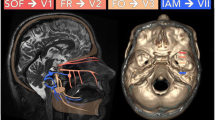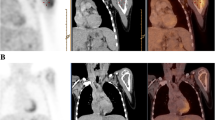Abstract
Purpose
Our objective was to determine how positron emission tomography (PET)/CT had been used in the clinical treatment of malignant peripheral nerve sheath tumor (MPNST) patients at The University of Texas MD Anderson Cancer Center.
Methods
We reviewed a database of MPNST patients referred to MD Anderson Cancer Center during 1995–2011. We enrolled 47 patients who underwent PET/CT imaging. Disease stage was based on conventional imaging and PET/CT findings using National Comprehensive Cancer Network (NCCN) guidelines. Treatment strategies based on PET/CT and conventional imaging were determined by chart review. The maximum and mean standardized uptake values (SUVmax, SUVmean), metabolic tumor volume (MTV), total lesion glycolysis (TLG), change in SUVmax, change in MTV, and change in TLG were calculated from the PET/CT studies before and after treatment. Response prediction was based on imaging studies performed before and after therapy and categorized as positive or negative for residual tumor. Clinical outcome was determined from chart review.
Results
PET/CT was performed for staging in 16 patients, for restaging in 29 patients, and for surveillance in 2 patients. Of the patients, 88 % were correctly staged with PET/CT, whereas 75 % were correctly staged with conventional imaging. The sensitivity to detect local recurrence and distant metastasis at restaging was 100 and 100 % for PET/CT compared to 86 and 83 % for conventional imaging, respectively. PET/CT findings resulted in treatment changes in 31 % (5/16) and 14 % (4/29) of patients at staging and restaging, respectively. Recurrence, MTV, and TLG were prognostic factors for survival, whereas SUVmax and SUVmean were not predictive. For 21 patients who had imaging studies performed both before and after treatment, PET/CT was better at predicting outcome (overall survival, progression-free survival) than conventional imaging. A decreasing SUVmax ≥ 30 % and decrease in TLG and MTV were significant predictors for overall and progression-free survival.
Conclusion
PET/CT is valuable in MPNST management because of its high accuracy in staging and high sensitivity and accuracy in restaging as well as improvements in treatment planning. MTV from baseline staging studies is predictive of survival. Additionally, change in SUVmax, TLG, and MTV accurately predicted outcomes after treatment.





Similar content being viewed by others
References
Anghileri M, Miceli R, Fiore M, Mariani L, Ferrari A, Mussi C, et al. Malignant peripheral nerve sheath tumors: prognostic factors and survival in a series of patients treated at a single institution. Cancer 2006;107:1065–74. doi:10.1002/cncr.22098.
Louis DN, Ohgaki H, Wiestler OD, Cavenee WK, Burger PC, Jouvet A, et al. The 2007 WHO classification of tumours of the central nervous system. Acta Neuropathol 2007;114:97–109. doi:10.1007/s00401-007-0243-4.
Stark AM, Buhl R, Hugo HH, Mehdorn HM. Malignant peripheral nerve sheath tumours–report of 8 cases and review of the literature. Acta Neurochir (Wien) 2001;143:357–63. discussion 63–4.
Benz MR, Czernin J, Dry SM, Tap WD, Allen-Auerbach MS, Elashoff D, et al. Quantitative F18-fluorodeoxyglucose positron emission tomography accurately characterizes peripheral nerve sheath tumors as malignant or benign. Cancer 2010;116:451–8. doi:10.1002/cncr.24755.
Ferner RE, Golding JF, Smith M, Calonje E, Jan W, Sanjayanathan V, et al. [18F]2-fluoro-2-deoxy-D-glucose positron emission tomography (FDG PET) as a diagnostic tool for neurofibromatosis 1 (NF1) associated malignant peripheral nerve sheath tumours (MPNSTs): a long-term clinical study. Ann Oncol 2008;19:390–4. doi:10.1093/annonc/mdm450.
NCCN clinical practice guidelines in oncology. Soft tissue sarcoma. Version 3.2012. http://www.nccn.org/professionals/physician_gls/pdf/sarcoma.pdf. Accessed 1 Oct 2012.
Hyun SH, Choi JY, Shim YM, Kim K, Lee SJ, Cho YS, et al. Prognostic value of metabolic tumor volume measured by 18F-fluorodeoxyglucose positron emission tomography in patients with esophageal carcinoma. Ann Surg Oncol 2010;17:115–22. doi:10.1245/s10434-009-0719-7.
Paulino AC, Koshy M, Howell R, Schuster D, Davis LW. Comparison of CT- and FDG-PET-defined gross tumor volume in intensity-modulated radiotherapy for head-and-neck cancer. Int J Radiat Oncol Biol Phys 2005;61:1385–92. doi:10.1016/j.ijrobp.2004.08.037.
Schinagl DA, Vogel WV, Hoffmann AL, van Dalen JA, Oyen WJ, Kaanders JH. Comparison of five segmentation tools for 18F-fluoro-deoxy-glucose-positron emission tomography-based target volume definition in head and neck cancer. Int J Radiat Oncol Biol Phys 2007;69:1282–9. doi:10.1016/j.ijrobp.2007.07.2333.
Tateishi U, Yamaguchi U, Seki K, Terauchi T, Arai Y, Kim EE. Bone and soft-tissue sarcoma: preoperative staging with fluorine 18 fluorodeoxyglucose PET/CT and conventional imaging. Radiology 2007;245:839–47. doi:10.1148/radiol.2453061538.
Gordon BA, Flanagan FL, Dehdashti F. Whole-body positron emission tomography: normal variations, pitfalls, and technical considerations. AJR Am J Roentgenol 1997;169:1675–80. doi:10.2214/ajr.169.6.9393189.
Al-Ibraheem A, Buck AK, Benz MR, Rudert M, Beer AJ, Mansour A, et al. (18) F-fluorodeoxyglucose positron emission tomography/computed tomography for the detection of recurrent bone and soft tissue sarcoma. Cancer 2013;119:1227–34. doi:10.1002/cncr.27866.
Mikhaeel NG, Timothy AR, O’Doherty MJ, Hain S, Maisey MN. 18-FDG-PET as a prognostic indicator in the treatment of aggressive non-Hodgkin’s lymphoma-comparison with CT. Leuk Lymphoma 2000;39:543–53. doi:10.3109/10428190009113384.
Roberge D, Vakilian S, Alabed YZ, Turcotte RE, Freeman CR, Hickeson M. FDG PET/CT in initial staging of adult soft-tissue sarcoma. Sarcoma. 2012;2012:960194. doi:10.1155/2012/960194.
Gregory DL, Hicks RJ, Hogg A, Binns DS, Shum PL, Milner A, et al. Effect of PET/CT on management of patients with non-small cell lung cancer: results of a prospective study with 5-year survival data. J Nucl Med 2012;53:1007–15. doi:10.2967/jnumed.111.099713.
Law A, Peters LJ, Dutu G, Rischin D, Lau E, Drummond E, et al. The utility of PET/CT in staging and assessment of treatment response of nasopharyngeal cancer. J Med Imaging Radiat Oncol 2011;55:199–205. doi:10.1111/j.1754-9485.2011.02252.x.
Lonneux M, Hamoir M, Reychler H, Maingon P, Duvillard C, Calais G, et al. Positron emission tomography with [18F]fluorodeoxyglucose improves staging and patient management in patients with head and neck squamous cell carcinoma: a multicenter prospective study. J Clin Oncol 2010;28:1190–5. doi:10.1200/JCO.2009.24.6298.
Kar M, Deo SV, Shukla NK, Malik A, DattaGupta S, Mohanti BK, et al. Malignant peripheral nerve sheath tumors (MPNST)–clinicopathological study and treatment outcome of twenty-four cases. World J Surg Oncol 2006;4:55. doi:10.1186/1477-7819-4-55.
Porter DE, Prasad V, Foster L, Dall GF, Birch R, Grimer RJ. Survival in malignant peripheral nerve sheath tumours: a comparison between sporadic and neurofibromatosis type 1-associated tumours. Sarcoma 2009;2009:756395. doi:10.1155/2009/756395.
Brenner W, Friedrich RE, Gawad KA, Hagel C, von Deimling A, de Wit M, et al. Prognostic relevance of FDG PET in patients with neurofibromatosis type-1 and malignant peripheral nerve sheath tumours. Eur J Nucl Med Mol Imaging 2006;33:428–32. doi:10.1007/s00259-005-0030-1.
Benz MR, Czernin J, Allen-Auerbach MS, Tap WD, Dry SM, Elashoff D, et al. FDG-PET/CT imaging predicts histopathologic treatment responses after the initial cycle of neoadjuvant chemotherapy in high-grade soft-tissue sarcomas. Clin Cancer Res 2009;15:2856–63. doi:10.1158/1078-0432.CCR-08-2537.
Evilevitch V, Weber WA, Tap WD, Allen-Auerbach M, Chow K, Nelson SD, et al. Reduction of glucose metabolic activity is more accurate than change in size at predicting histopathologic response to neoadjuvant therapy in high-grade soft-tissue sarcomas. Clin Cancer Res 2008;14:715–20. doi:10.1158/1078-0432.CCR-07-1762.
Young H, Baum R, Cremerius U, Herholz K, Hoekstra O, Lammertsma AA, et al. Measurement of clinical and subclinical tumour response using [18F]-fluorodeoxyglucose and positron emission tomography: review and 1999 EORTC recommendations. European Organization for Research and Treatment of Cancer (EORTC) PET Study Group. Eur J Cancer 1999;35:1773–82.
Wahl RL, Jacene H, Kasamon Y, Lodge MA. From RECIST to PERCIST: evolving considerations for PET response criteria in solid tumors. J Nucl Med 2009;50 Suppl 1:122S–50. doi:10.2967/jnumed.108.057307.
Herrmann K, Benz MR, Czernin J, Allen-Auerbach MS, Tap WD, Dry SM, et al. 18F-FDG-PET/CT imaging as an early survival predictor in patients with primary high-grade soft tissue sarcomas undergoing neoadjuvant therapy. Clin Cancer Res 2012;18:2024–31. doi:10.1158/1078-0432.CCR-11-2139.
Tateishi U, Kawai A, Chuman H, Nakatani F, Beppu Y, Seki K, et al. PET/CT allows stratification of responders to neoadjuvant chemotherapy for high-grade sarcoma: a prospective study. Clin Nucl Med 2011;36:526–32. doi:10.1097/RLU.0b013e3182175856.
Acknowledgments
We thank Treva Greer, Nancy M. Swanson, Richelle D. Millican, and Dr. Pan Tinsu for providing help with data transfer and image acquisition. This article was edited by Luanne Jorewicz in the Department of Scientific publications at The University of Texas MD Anderson Cancer Center.
Conflicts of interest
This work was supported in part by the National Cancer Institute through Cancer Center Support Grant (P30 CA016672), the MD Anderson Cancer Center James E. Anderson Distinguished Professorship. Dr. Hubert H. Chuang is a collaborator on a clinical trial sponsored by Spectrum Pharmaceuticals. The other authors have no other potential conflicts of interest relevant to this article. This work was presented in part at the Society of Nuclear Medicine and Molecular Imaging Annual Meeting, Vancouver, Canada, between 8 and 12 June 2013.
Author information
Authors and Affiliations
Corresponding author
Rights and permissions
About this article
Cite this article
Khiewvan, B., Macapinlac, H.A., Lev, D. et al. The value of 18F-FDG PET/CT in the management of malignant peripheral nerve sheath tumors. Eur J Nucl Med Mol Imaging 41, 1756–1766 (2014). https://doi.org/10.1007/s00259-014-2756-0
Received:
Accepted:
Published:
Issue Date:
DOI: https://doi.org/10.1007/s00259-014-2756-0




